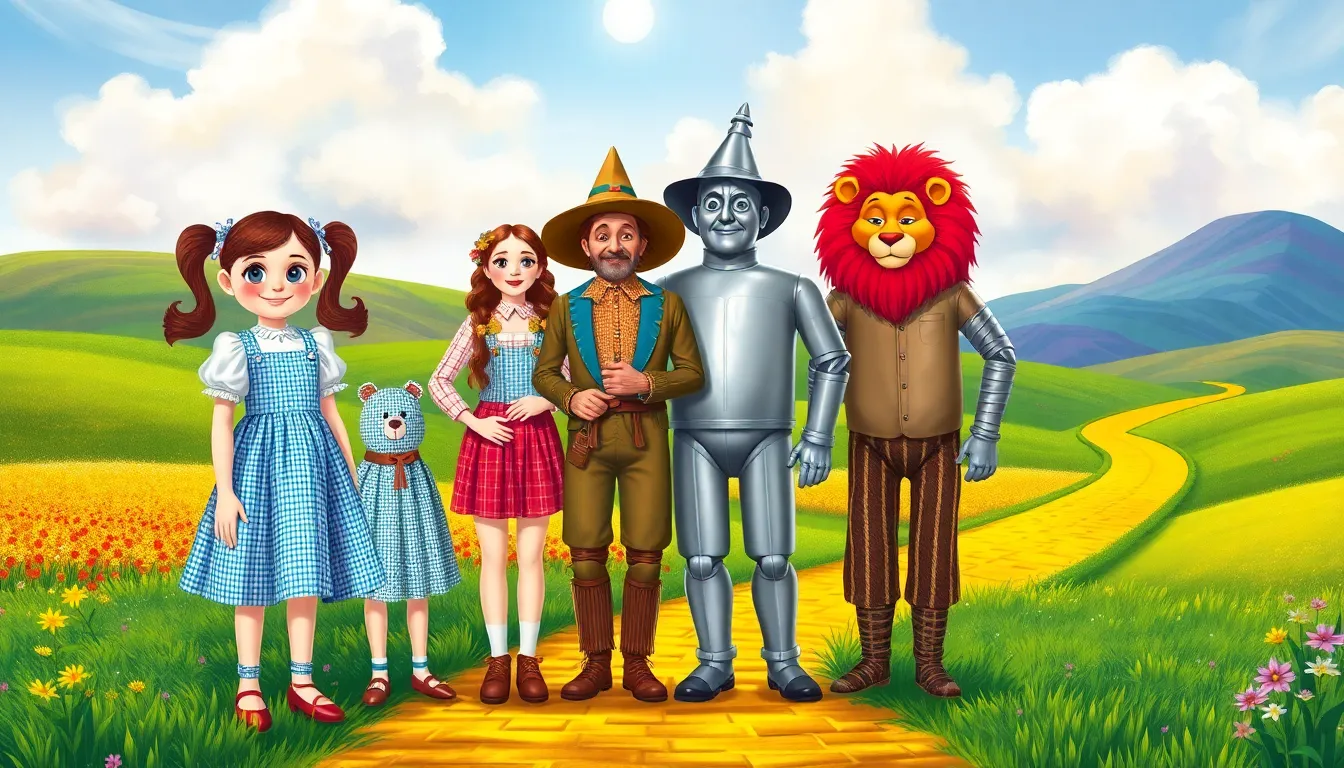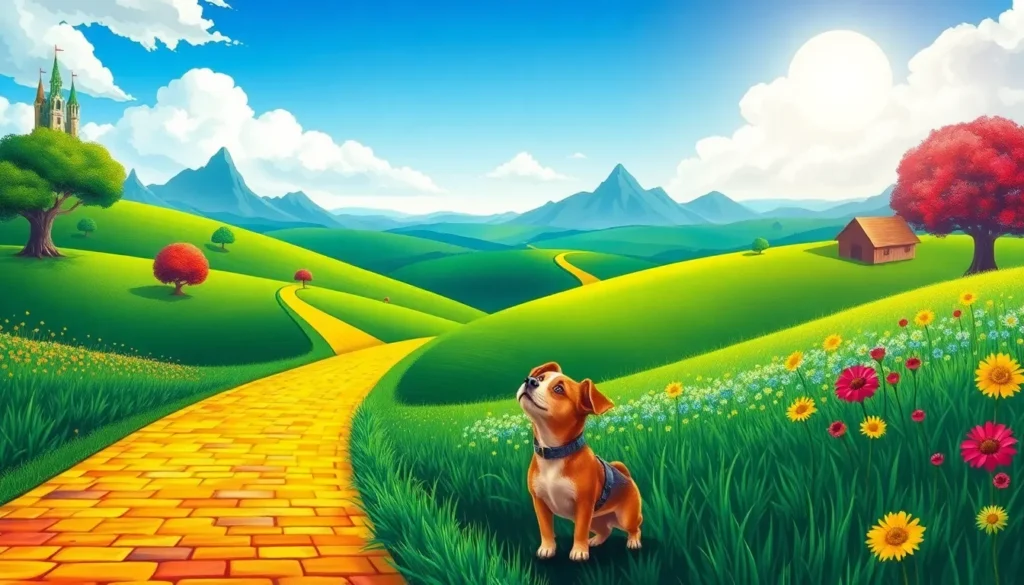Imagine a world where yellow brick roads lead to fantastical adventures, talking animals offer sage advice, and the line between reality and imagination blurs like a well-worn VHS tape. The Wizard of Oz isn’t just a movie; it’s a portal to a realm of wonder that leaves viewers humming “Somewhere Over the Rainbow” long after the credits roll. But what happens when the credits roll on this classic?
movies like wizard of oz
“The Wizard of Oz,” released in 1939, stands as a hallmark of American cinema. This musical fantasy film, based on L. Frank Baum’s book, transports audiences to the enchanting land of Oz. Viewers follow Dorothy, played by Judy Garland, as she journeys to find her way home after being swept away by a tornado. Along her path, she meets memorable characters like the Scarecrow, the Tin Man, and the Cowardly Lion.
Imagery plays a pivotal role in the film’s allure. Vivid colors and innovative visual effects capture the imagination, especially in scenes like the transition from sepia-toned Kansas to the bright, colorful Oz. Iconic songs such as “Somewhere Over the Rainbow” resonate emotionally, contributing to the film’s legacy. Music enriches the narrative, intertwining seamlessly with the character’s experiences.
Cultural significance amplifies the film’s status. “The Wizard of Oz” has influenced countless other films, Broadway adaptations, and even study curricula. Themes of friendship, courage, and self-discovery connect with multiple generations. Numerous quotes from the movie permeate everyday language, showcasing its enduring presence in popular culture.
Adaptations abound, including television specials and remakes, illustrating the story’s timeless appeal. New audiences discover the charm of the film, ensuring its relevance persists. Overall, “The Wizard of Oz” captivates viewers not just through its storyline but also through a rich tapestry of visual artistry and musical accompaniment.
Key Themes in “The Wizard of Oz”

“The Wizard of Oz” embodies rich themes that resonate deeply with audiences. Friendship and loyalty underscore the film’s narrative, and the journey to self-discovery plays a crucial role in character development.
Friendship and Loyalty
Friendship emerges as a cornerstone of the film’s plot. Dorothy, Scarecrow, Tin Man, and Cowardly Lion unite to face challenges, showcasing unwavering support. Their bonds deepen through shared experiences in Oz. Loyalty enhances their relationships, as each character proves willing to sacrifice for one another. For instance, the lion ultimately demonstrates his bravery, reinforcing that true courage often lies in standing by friends. The film illustrates how genuine connections empower individuals to overcome obstacles together.
The Journey to Self-Discovery
The journey to self-discovery forms another significant theme in “The Wizard of Oz.” Dorothy seeks to return home but, along her path, discovers her inner strength. The Scarecrow longs for intelligence, the Tin Man yearns for a heart, and the Cowardly Lion seeks courage. Each character undergoes personal growth, revealing that these attributes already exist within themselves. Dorothy’s iconic realization of “there’s no place like home” symbolizes the importance of self-acceptance and understanding one’s desires. The film ultimately conveys that the quest for self-discovery enriches the human experience, leading to profound transformations.
Movies Like “The Wizard of Oz”
Several films capture the whimsical essence of “The Wizard of Oz,” reflecting its enchanting themes and magical journeys.
Classic Fantasy Films
“Peter Pan,” released in 1953, transports viewers to Neverland, mirroring the fantastical adventure found in Oz. “Alice in Wonderland,” a 1951 Disney adaptation, explores surreal visuals and quirky characters, creating a dreamlike narrative. “The Adventures of Prince Achmed,” made in 1926, distinguishes itself with stunning silhouette animation and a captivating storyline reminiscent of magical tales. “Chitty Chitty Bang Bang,” arriving in 1968, combines musical elements with imaginative landscapes, providing a delightful family experience akin to Dorothy’s journey. “The Wizard of Oz” inspires this rich tradition of classic fantasy, showcasing the timeless allure of adventure and friendship.
Modern Adaptations
“Return to Oz,” featuring a darker spin, continues Dorothy’s adventures in 1985. This film embraces a unique perspective while maintaining the original’s charm. “The Wonderful Wizard of Oz,” a 2005 animated adaptation, offers engaging storytelling and vibrant visuals, appealing to new generations. “Oz the Great and Powerful,” released in 2013, serves as a prequel, exploring the origins of well-known characters and their enchanting world. “The Wiz,” a 1978 musical adaptation, infuses contemporary music and performances, making it resonate with diverse audiences. Each adaptation connects deeply with the essence of the original film, ensuring that its magical legacy thrives.
Impact on Popular Culture
“The Wizard of Oz” profoundly influenced American culture and entertainment. Known for its colorful visuals and memorable songs, it introduced iconic phrases like “There’s no place like home” into the vernacular, often cited in various contexts. The film’s imagery and themes resonate, inspiring countless parodies, references, and homages across media.
Diverse adaptations showcase its impact. Broadway adaptations revitalized the story for live audiences, ensuring its legacy thrives through stage performances. Television specials, such as “The Wiz,” reinterpret the narrative while attracting new fans. Each retelling highlights the film’s universal themes of courage, friendship, and self-discovery, appealing to multiple generations.
Merchandising effectively capitalized on the film’s allure. Toys, apparel, and collectibles reflecting beloved characters became popular items, ensuring continued engagement with the brand. The movie’s seasonal television broadcasts fostered traditions, creating family rituals around viewing the classic.
Influencing filmmakers significantly, “The Wizard of Oz” set the standard for fantasy storytelling. Visionary directors cite it as inspiration for their projects. In film festivals, reverence for this classic remains evident, showcasing its ongoing relevance and popularity.
Cultural celebrations frequently incorporate elements from Oz. Festivals honor the spirit of adventure and community found in the story. The film’s emotional resonance fosters connections across diverse audiences, reinforcing its status as a timeless piece of cinematic history.
Conclusion
The enchanting legacy of “The Wizard of Oz” continues to inspire and captivate audiences of all ages. Its themes of friendship, courage, and self-discovery resonate deeply, making it a timeless classic. As viewers explore films that echo its whimsical spirit, they uncover new adventures that spark the imagination.
From the vibrant worlds of “Peter Pan” to the magical journeys in “Alice in Wonderland,” each film offers a unique take on the elements that make “The Wizard of Oz” so beloved. As adaptations evolve and new generations discover these stories, the magic of Oz lives on, reminding everyone of the importance of home and the bonds we share.

